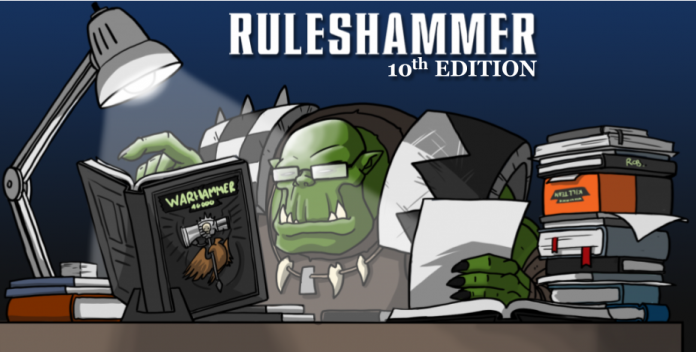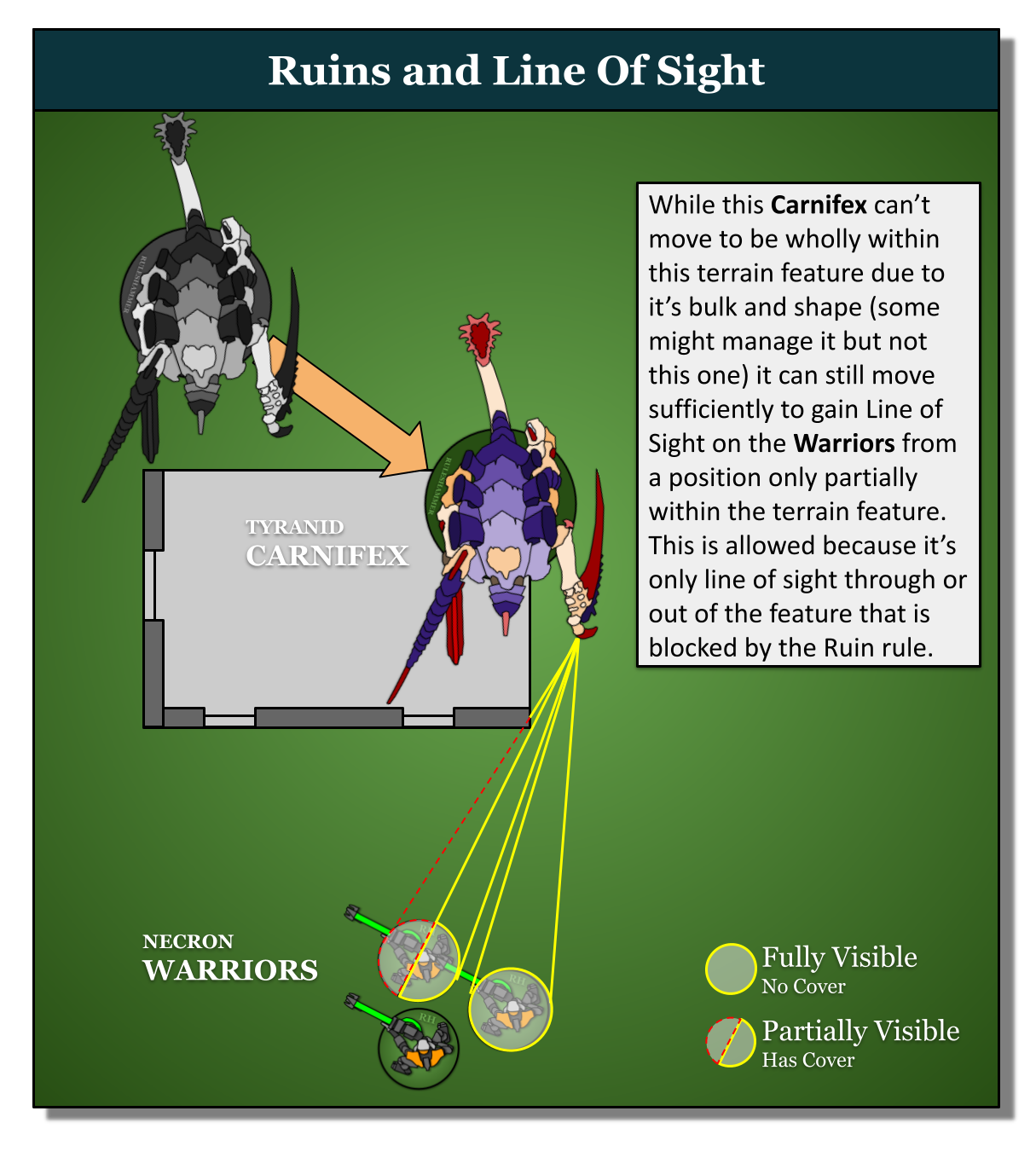Welcome to Ruleshammer! This week my first notes and musings on 10th edition. Things I think you should look out for in early games.
A Brief note about Cover and Line of Sight
Arguably some of the largest changes to the game are within these rules. Maybe even wholly within them… The one I want to talk about this week though is seeing out and through terrain and how drastically different that is from 9th edition. I think Games Workshop their their credit has done a good job this edition with the cover rule language, it’s for the most part super clear, there’s not conflicting sections. They’ve done an even better job with the diagrams in the Rules Commentary, a document I’m sure this column will be referring to a lot as the edition progresses.
One that has caused some waves in the 40k community is this diagram.

Unlike 9th editions obscuring rule the Line of Sight limitations of 10th Edition ruins require models to be wholly within the area before you can “see out”. A change that even us here at the Goonhammer Offices have hotly debated. I personally like this change but I can see how it might frustrate others. Frequent readers might know how frustrated I could be with how easy terrain was to ignore in 9th edition, especially with foot prints wider than the actual terrain piece. I have however seen a few takes or first impressions on this that I think are premature or not taking into account how much agency the controlling player has in if targets get cover in 10th edition. For instance this scenario below.
More so than in 9th edition moving large models will require some pros and cons analysis. To offset this change though these same models will benefit from cover in return, further increasing their resilience to small arms fire over and above the changes to Toughness and wounds.
Early Q&A
Before I get started on my usual weekly Q&A here’s a few questions from the first days of this new edition I’ve seen a lot.
Modifiers
So largely this isn’t changed from 9th edition, the order is the same as it has been for a while.
MODIFIERS
Modifiers are rules that change a numerical value from one value to another. This can include the result of a dice roll, the characteristics of a model, and more. This section details how to apply modifiers in your games. In all cases:
1. All modifiers are cumulative.
2. If a rule instructs you to change or replace one characteristic with a specified value, change the relevant characteristic to the new value before applying any modifiers that apply from other rules (if any) to the new value.
3. You must then apply division modifiers before applying multiplication modifiers, before applying addition and the subtraction modifiers.
4. Round any fractions up after applying all modifiers.
However there are a few quirks that I think might come up reasonable often. One of them is even included as an example in the Rules Commentary.
Example 2b:The same Intercessor unit from Example 2a becomes Battle-shocked, changing the OC characteristic of its models to 0. This happens before the Chitinous Horrors and Astartes Banner modifiers are applied, meaning the final, modified OC of each Intercessor model in that unit is 1 (2 –> 0, then 0/2 = 0, then 0+1=1).
What isn’t mentioned is that a change to Meltas has them function the exact same way into any abilities that reduce damage to 0. Meltas in 9th edition were not additive modifiers, they changed the whole characteristics from D6 to usually D6+2 (there were some better Meltas the did more) but because they changed it in that way that modification occurred first and then any abilities to set damage to 0 happened later (though on reflection I’m not even sure this order was set in stone back then).
In 10th Meltas are explicitly an addition. So any abilities that set damage to 0 will occur before that addition, and the damage will then add X.
Weapons with [MELTA X] in their profile are known as Melta weapons. Each time an attack made with such a weapon targets a unit within half that weapon’s range, that attack’s Damage characteristic is increased by the amount denoted by ‘x’.
Maybe this will be FAQed, but it also might not be as it’s not actually ambiguous.
Transports from Reserve – can their passengers Disembark?
Probably not. Or at least I don’t think they’re meant to be able to. 10th edition made some core changes to Transports and Reserve that removed some of the barriers to doing this in 9th edition.
- Units Transports in transports can now disembark even if the Transport has made a normal move.
- Units that arrive from Reserve now count as having made a Normal Move, rather than just counting as “moved” without a type as they did in 9th.
Disembark the rule itself doesn’t exactly help by still being vague about when Disembarking is allowed occur. It’s just something a unit can do in the Movement Phase if the unit started the turn Embarked. It doesn’t specify a step of the phase it has to do it in.
So why do I think it’s not intended? Primarily because there are still transports that have disembarking when they arrive explicitly included in their abilities. Secondly because there’s no general rule that requires these units to set up outside of 9″, this restriction is wholly reliant on the ability they use to be set up and Disembark for obvious reasons does not have that restriction.
It’s worth noting that even if it did work, it’s only a problem for thing such as being able to disembark into Melta range, rather than also allowing for extra short charges. This is because units that disembark from a transport that has moved can’t declare a charge. A limitation that oddly still applies to Transports such as the Drop Pod.
Are Abilities that Give CP at the start of the Command Phase excluded from the Cap?
Not currently RAW. But wow does that suck, especially as there’s abilities that are clearly meant to award multiple CP but would instantly hit the camp.
If, at the start of any of your Command phases, your selected Oath’s Deed is completed, your army becomes Honoured for the rest of the battle and you gain 3CP (you can only gain CP in this way once per battle). – Imperial Knights, CODE CHIVALRIC
but then there are also very similar abilities that literally have an exception written in…
If, at the start of any of your Command phases, that enemy unit is destroyed, you gain a number of CP depending on how early in the battle you destroyed it, as shown below (you can only gain CP in this way once per battle, and CP gained in this way are an exemption to the Core Rules that limit the maximum number of CP you can gain per battle round to 1). – League of Votann, RUTHLESS EFFICIENCY
which implies an exception is necessary. Personally I think the Votann rule is just confusing the issue and many of these rules are meant to work as expected.
Have any questions or feedback? Got a rules question you want answered? Drop us a note in the comments below, ask a question in our Ruleshammer form, or head over to r/ruleshammer to discuss.





You must be logged in to post a comment.